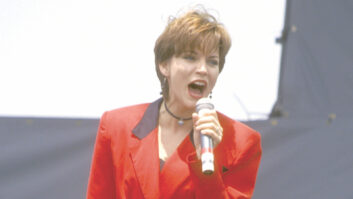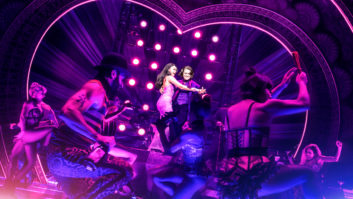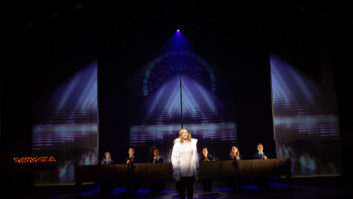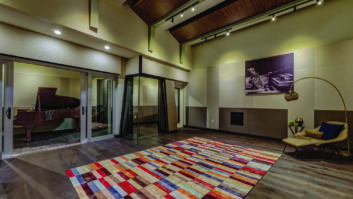Musical theater has been strikingly successful in adapting and refining the modern sound reinforcement technologies that blossomed in the ’70s. In fact, many of today’s most sophisticated sound system designs can be found on Broadway, where it is not uncommon for a production to include dozens of loudspeaker locations, scores of wireless microphones, and hundreds of cues being triggered by automation, MIDI control and even humans.
At the same time, the audience for musical theater is becoming increasingly sophisticated. “CD quality” sound systems are ubiquitous in the home and car, and most members of today’s theater audiences have heard 5.1 or 7.1 surround sound in movie theaters. As home theater installations continue to siphon off a growing percentage of the entertainment dollar, theater sound designers must strive to deliver the best sound quality possible. If they fail, that part of the audience that cares about sound will go elsewhere.
Fortunately, good sound quality is now more dependent on the correct application of currently available tools than on the development of new technology-the components for most musicals can be ordered from stock. So the problems that remain are often a result of the mismatch between the principles of sound design and the traditions of live theater. Some of these problems are inescapable, and much of the satisfaction of sound design comes from finding an appropriate way to solve the problem within the artistic and budgetary constraints of the production. But some recurring sound design problems are largely the result of outmoded thinking on the part of producers and designers.
THE ACOUSTIC MODELIn most musical productions the actors are onstage and the musicians are in the pit. The audience sits in the auditorium and, in the case of a popular show, has probably paid dearly for the privilege of hearing both singers and musicians in something approaching a reasonable balance. This is the traditional format for musicals, and it has remained, with some exceptions, unchanged for decades.
Traditionally, the balance between musicians and singers has been controlled by the conductor; if the singer’s projection is weak, the conductor holds the orchestra back. or so goes the theory. However, because of the natural limitations of actors’ voices, an acoustic balance between voices and orchestra balance can rarely be achieved.
But progress waits for no man. Enter the sound designer, with red cape flapping and blue tights a-chafing. Advances in sound equipment technology and practice have made it possible to amplify either the vocalists, or the musicians, or both. Weak singers now have careers in musicals, and musicians “can” (and sometimes do) play without regard to their surroundings, knowing that the FoH mixer will balance their instruments in mix.
However, there are some problems associated with this otherwise sunny scenario. First, the theater’s acoustics usually cannot be much improved; most productions only rent the space for a matter of months, so any inherent acoustical problems have to be worked around. And though some houses have better acoustics than others, all theaters more than a few decades old were originally designed to naturally amplify any and all sounds coming from the pit and stage. This unchangeable acoustic character is not always helpful.
For example, a pit orchestra will often put out an average level of 74dB SPL, unamplified. To supplement or overcome the sound of the instruments’ acoustic mix, which is often blurred and muffled by being reflected from scenery, the theater walls and ceiling, the sound system has to rise above the orchestra, to an average level of 80dB SPL. Since today’s audience expects 95% intelligibility, actors generally use wireless microphones, and the vocal level rises to an average of 86dB SPL, leaving the sound designer with little room for vocal nuance, especially when the actor’s microphone is buried under a wig or hat.
And that is the best-case scenario. In many instances, the producer reduces the size of the orchestra pit in order to cram in more seats. The production’s scenic designer may place beams and other devices in the pit. Sound and music departments are faced with the task of cramming the musicians into the remaining space, regardless of the pit orchestra’s preferred positioning for internal acoustic balance.
As there is often no room in the orchestra pit for baffles, instruments leak into other instrument’s mics. An acoustic instrument mic soloed can sound like the entire orchestra mixed on acid. Contact mics and clip-ons can help, but sound quality tends to suffer.
A MODEST PROPOSALMy answer to this problem is to remove some of the orchestra players from the pit. Placing the musicians in another location that is isolated from the auditorium will fix the musician’s seating problem and greatly improve the quality of each instrument’s amplified sound. The overall sound mix will be completely controllable throughout the auditorium, since there will no longer be any direct sound from the pit (most of which is detrimental to the final mix anyway). Further, the actors’ voices can now be mixed at a level that matches the scene.
How will the orchestra conductor, used to keeping the musicians balanced with the actors onstage, maintain that balance once the two are performing in separate spaces? No problem. A well-planned video and monitor mix system will allow the conductor to cue the musicians to the actors’ performance.
Monitor systems for musical theater are already commonplace: My recent sound design for The Music Man includes eight different monitor mixes for the musicians in the pit. Looking over my sound designs for the last few years, I noticed that I wound up with an average of six monitor mixes for musicians alone. For a rock or music concert system, this number of monitor mixes seems minimal, but theater systems traditionally only have one mixing board, at the FoH position in the auditorium. Eight monitor mixes means that many aux bus sends are not available for effects sends and other uses, a severe limitation in the sound design.
I think it is now time to throw off the shackles of “conventional” theater sound design and place a full-on monitor console backstage. The deck/backstage sound person can control all orchestra monitor and stage foldback requirements from this additional console; it’s a plan that is far more workable than current practice, which usually involves a lot of messages to the FoH engineer from backstage via intercom. The FoH engineer would then be free to focus on mixing for the audience, undistracted by having to deal with backstage or pit mixes.
But perhaps I’m barking up the wrong tree. As theater sound buffs already know, the most recent Tony Award winner for Best New Musical is a show called Contact. This show is truly a brilliant production and deserves the many accolades it has already received. But Contact is a musical with 100% pre-recorded music; there’s not a single live musician in the production. If the future of live musical theater is going to depend on the reproduction of needle-drop music, then my proposals for separate FoH and monitor mixers may prove moot.
But, for the moment, I choose to believe that live musical theater, accompanied by live musicians, has a future and that audiences will become more discriminating and more demanding. In that case, it is time for theater sound to abandon the conventions surrounding pit orchestras and single-console sound designs and apply the lessons learned by touring bands over the past few decades. I predict that the future of sound design for musical theater will include multiple mix positions and offstage, or isolated, orchestra positions, where instrument mics may be positioned for the best sound, not just where they will fit.






